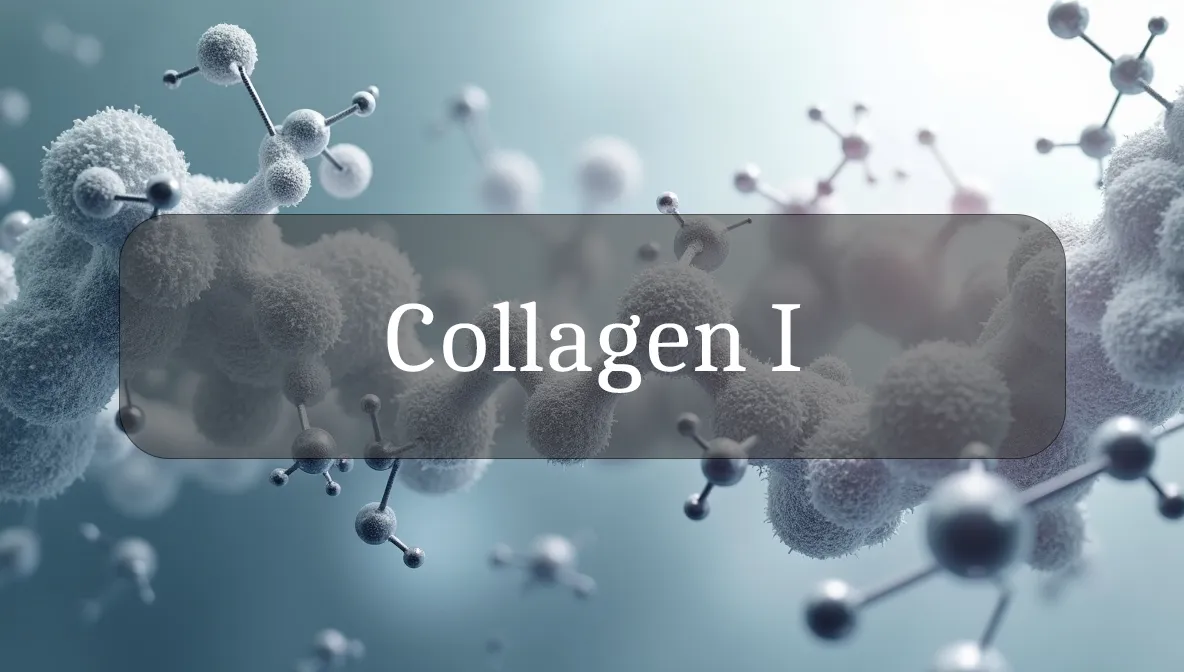Your Body’s Structural Foundation
Collagen I is the most abundant protein in your body, forming the structural backbone of bones, skin, tendons, and other connective tissues. As a key component of your extracellular matrix, it provides strength and resilience, supporting overall health and mobility. Let’s explore what Collagen I is, its role in your wellness, and how to support its function for daily vitality.
Identity and Function
Collagen I is a fibrous protein (~300 kDa) composed of three polypeptide chains (two α1 and one α2) encoded by the COL1A1 and COL1A2 genes on chromosomes 17 and 7, respectively. It forms a triple helix structure, giving it exceptional tensile strength. Synthesized by fibroblasts, osteoblasts, and other cells, Collagen I is assembled into strong fibrils that provide structural support and elasticity to tissues. It’s critical for maintaining tissue integrity and facilitating repair.
Biological Role and Health Impact
Collagen I is essential for physical strength and tissue health:
- Bone Strength: It forms the organic matrix of bones (90% of bone protein), providing flexibility and a scaffold for mineral deposition, preventing fractures.
- Skin Integrity: It gives skin its structure and firmness, reducing sagging and supporting a youthful appearance.
- Tendon and Ligament Support: It provides tensile strength for movement and joint stability, enhancing mobility and athletic performance.
- Wound Healing: It supports tissue repair by forming a framework for new cell growth, aiding recovery from cuts or injuries.
- Organ Structure: It contributes to the structural integrity of blood vessels, cartilage, and organs, supporting cardiovascular and systemic health.
By maintaining strong tissues, Collagen I keeps you mobile, resilient, and structurally sound.
Production and Sources
Collagen I is produced internally and influenced by diet and lifestyle:
- Endogenous Synthesis: Fibroblasts and osteoblasts synthesize Collagen I using amino acids (glycine, proline, hydroxyproline) and enzymes like prolyl hydroxylase. Synthesis declines with age (~1% per year after age 20).
- Dietary Sources: Collagen is not consumed directly but supported by protein-rich foods (chicken, fish, eggs; 20–30g/serving) providing amino acids. Collagen supplements (hydrolyzed collagen, 5–15g/day) may boost production.
- Key Nutrients: Vitamin C (citrus, peppers; 75–90 mg/day) is critical for collagen synthesis, acting as a cofactor for hydroxylation. Zinc (oysters, seeds; 8–11 mg/day), copper (shellfish, nuts), and manganese (whole grains) support enzyme activity.
- External Factors: UV exposure, smoking, and high sugar intake degrade collagen, while exercise and hydration promote synthesis.
A nutrient-rich diet and healthy habits optimize Collagen I production.
Signs of Imbalance
Collagen I imbalances, often from reduced synthesis or degradation, can affect health:
- Insufficient Collagen I:
- Symptoms: Brittle bones (osteoporosis risk), joint pain, sagging skin, wrinkles, or slow wound healing due to reduced tissue strength.
- Causes: Aging, vitamin C deficiency, genetic disorders (e.g., osteogenesis imperfecta), or chronic inflammation.
- Affects ~10% of older adults with low bone density or skin thinning.
- Excess Collagen I (Rare):
- Symptoms: Fibrosis or excessive scarring (e.g., keloids), causing stiff tissues or organ dysfunction in conditions like scleroderma.
- Causes: Overactive fibroblasts or chronic inflammation (e.g., liver fibrosis).
- Structural Defects:
- Symptoms: Fragile bones, hypermobile joints, or easy bruising in genetic disorders like Ehlers-Danlos syndrome or osteogenesis imperfecta.
- Diagnosed via genetic testing or bone density scans.
If you notice joint pain, frequent fractures, or skin changes, see a doctor for tests like bone density (DEXA), vitamin C levels, or genetic screening.
Supporting Healthy Function
To optimize Collagen I production and maintain tissue health:
- Eat Protein-Rich Foods: Include lean meats (chicken, 25g protein/100g), fish (salmon, 20g/100g), or plant proteins (beans, 8g/100g) to supply amino acids for collagen synthesis.
- Boost Vitamin C: Consume citrus fruits, strawberries, or bell peppers (75–90 mg/day) to support collagen formation. Pair with protein meals for synergy.
- Support with Nutrients: Include zinc (pumpkin seeds, 2 mg/30g), copper (shellfish, 0.9 mg/100g), and manganese (oats, 1 mg/30g) to enhance collagen enzymes.
- Exercise Regularly: Engage in strength training or weight-bearing exercise (e.g., walking, lifting, 30 min 5 days/week) to stimulate collagen production in bones and tendons.
- Protect Skin: Use sunscreen (SPF 30+), avoid smoking, and limit sugar to prevent collagen breakdown. Stay hydrated (8–12 cups water/day) for tissue elasticity.
Safety and Precautions
Collagen I is naturally regulated, but health conditions require care:
- Medical Conditions: Osteoporosis, arthritis, or genetic disorders (e.g., osteogenesis imperfecta) impair Collagen I function, needing medical management (e.g., bisphosphonates, physical therapy).
- Supplements: Hydrolyzed collagen (5–15g/day) is generally safe but may cause digestive upset. Choose reputable brands and consult a doctor if you have kidney issues.
- Aging: Collagen decline with age increases fracture or wrinkle risk. Regular bone density checks (every 1–2 years after 50) are advised for at-risk groups.
- Excess Risk: Overuse of collagen supplements is unlikely to cause harm but offers no extra benefit beyond 10–20g/day. Avoid unproven “collagen boosters.”
- Genetic Disorders: Rare conditions affecting Collagen I (e.g., Ehlers-Danlos) require specialized care. Avoid high-impact activities if joints are hypermobile.
If you have joint pain, fractures, or skin concerns, consult a healthcare provider for tests like DEXA scans, blood nutrient levels, or genetic analysis.
Fun Fact
Did you know Collagen I is stronger than steel by weight? Its triple-helix structure makes it so tough that your tendons can withstand forces that would snap weaker materials, keeping you moving like a superhero!
Citations
- National Institutes of Health (NIH): Collagen and Bone Health.
- American Academy of Dermatology: Collagen and Skin Aging.
- Journal of Bone and Mineral Research: Collagen I in Bone Structure (2020).
- Nutrients: Dietary Support for Collagen Synthesis (2021).
- Mayo Clinic: Osteoporosis and Connective Tissue Health.

